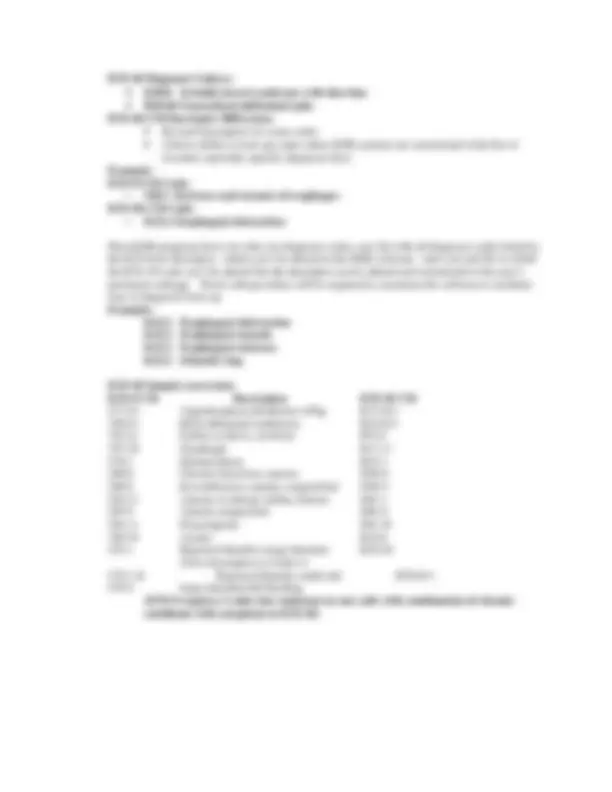




Study with the several resources on Docsity

Earn points by helping other students or get them with a premium plan


Prepare for your exams
Study with the several resources on Docsity

Earn points to download
Earn points by helping other students or get them with a premium plan
Community
Ask the community for help and clear up your study doubts
Discover the best universities in your country according to Docsity users
Free resources
Download our free guides on studying techniques, anxiety management strategies, and thesis advice from Docsity tutors
An overview of the upcoming transition from icd-9-cm to icd-10-cm diagnosis codes, focusing on the implications for gastroenterology and hepatology practices. The authors discuss the reasons for the transition, the structure of icd-10-cm codes, and provide examples of how the increased specificity of icd-10-cm can lead to reduced denials and improved disease management.
Typology: Summaries
1 / 4

This page cannot be seen from the preview
Don't miss anything!



Christopher Y Kim, MD, MBA, FASGE Kathleen A Mueller, RN, CPC, CGCS, CCS-P, CMSCS, PCS, CCC
November 2013
The current version of diagnosis codes used in the United States since 1979 is formally known as the International Classification of Diseases, Ninth Revision, Clinical Modification (ICD-9-CM) Volumes 1 and 2. Volume 3 is also used in Hospitals to record inpatient procedures. The ICD was developed by the World Health Organization (WHO) and is maintained in the US by the National Center for Health and Vital Statistics (NCHS), with the Centers for Disease Prevention and Control (CDC), under the US Department of Health and Human Services (HHS).
The Tenth Revision of ICD, also known as ICD-10-CM, will debut on October 1, 2014. Essentially overnight, the new codes will be required on services from that date going forward, and payers will no longer accept ICD-9 codes. Physician offices have just a little under a year to prepare for the transition to the ICD-10-CM diagnosis code sets. For years, HHS has been pushing to adopt the updated ICD-10 code standard that was endorsed by the WHO in 1990, and whose adoption was relatively swift in most of the world with the notable exception of the United States.
Reasons given by HHS for adopting ICD-10 include:
Fortunately for gastroenterology and hepatology, the vast majority of the current ICD-9 codes will map cleanly to an ICD-10-CM code.
The first phase to ICD-10 transformation, ASC standard, Version 5010, was put in place July 1, 2012. This involved updating billing software and electronic medical records for physician practices, facilities, and payers. The next phase is the conversion to ICD-10-CM on October 1, 2014.
ICD-10-CM: Structure Currently, 3-7 alphanumeric codes
Example ICD-9 vs. ICD-10-CM
ICD-10-CM: Case Study # A 50-year-old patient presents for his screening colonoscopy. There is no family history of colon cancer or polyps. Colonoscopy was completed to the cecum – bowel prep was good. Patient tolerated the procedure well. The following findings were noted. A descending colon polyp was removed by snare technique and a transverse colon polyp was removed by cold biopsy forceps. Both polyps were tubular adenomas per pathology. Advised follow-up was to repeat colonoscopy in 5 years.
Answer CPT: ICD-10-CM 45385-33 Z12.11 Encounter for colon screening, D12.4 Benign neoplasm, descending colon, 45380-59 D12.3 Benign neoplasm, transverse colon
With ICD-10-CM’s increased specificity as to location of benign neoplasms of the colon, this will theoretically reduce denials and/or request for records on multiple endoscopy claims
ICD-10-CM Case Study # A 54-year-old female comes in for follow-up of irritable bowel syndrome. She states that she has had diarrhea off and on for the past year. She has been under a lot of stress; her husband left her; and she recently lost her job. She denies any bleeding but complains of severe lower abdominal cramping relieved by passing gas.
Impression: Diarrhea, irritable bowel syndrome, generalized lower abdominal pain
ICD-10-CM Preparation (DO NOT DELAY, DO THIS ASAP)